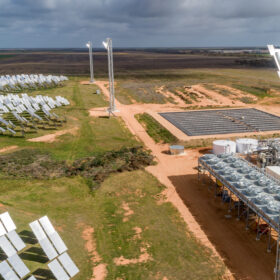The current 760 GW or so of worldwide installed solar may not have threatened the global silver lining, but the amount of silver needed to supply multi-terawatt-scale solar generation — critical to reducing carbon emissions from fossil fuels and limit global temperature rises to 1.5 degrees Celsius above pre-industrial levels — exceeds the earth’s known riches.
As the cheapest form of electricity generation, solar PV, combined with wind generation and storage technologies, holds the greatest promise for mitigating climate change. The challenge is to pursue technological developments that will maintain the low cost of generation, using less (if any) of already scarce materials such as silver, bismuth and indium, while scaling production to meet our future 70 TW needs in 2050.
Pierre Verlinden is renowned for his technical contributions to the photovoltaic industry over the past 40 years. Having spent several years in China as Chief Scientist for Trina Solar (a role he maintains on a part-time basis), he is also a director of Oxford PV and contributes to the commercialisation of the new solar-related technologies of companies such as BTimaging, RayGen and SunDrive.
As Adjunct Professor at the University of New South Wales’ School of Photovoltaic and Renewable Energy Engineering (SPREE), Verlinden has co-authored a paper released today: Design Considerations for Multi-terawatt Scale Manufacturing of Existing and Future Photovoltaic Technologies: Challenges and Opportunities Related to Silver, Indium and Bismuth Consumption.
pv magazine: Why has sustainability of the materials needed for solar cell manufacture become critically important?
Pierre Verlinden: PV growth has always been an exponential function, but it’s becoming apparent that it will be much bigger very soon. So what’s different now is that for the past 40 or 50 years the problem has always been to reduce cost and increase efficiency. But now the industry is at a very important juncture where we are approaching a terawatt of annual production. At the moment we have around 115 gigawatts, which is about a factor of six below the terawatt level. But because of the exponential growth in manufacturing, a factor of six is only a few years away. We cannot invest in technologies that are not sustainable. I’ve been saying it for many years — my first paper warning about sustainability was in 2013 — and the industry is just starting to realise that, yes, we need to do something. We have to make sure that the technology we use to meet the COP21 Paris agreement is sustainable,
So what surprised you about the research and conclusions arrived at in this paper?
I was not surprised at all. The current silicon technology represents more than 95% of annual solar cell production worldwide and three materials are critical: silver, indium and bismuth. If you look at just the PERC technology, which represents the bulk of production today, only silver is an issue. We need to reduce silver use in PERC production by a factor of four, maybe even seven if you really want to be sure, but we need to go from about 16 milligrams per watt to less than 5 million grams per watt. And that’s assuming that 50% of future world production of silver will be used for photovoltaics, which is huge. If we can’t access those 50%, then we have to reduce to about two milligrams per watt, or to nothing.
But in the case of other technologies … heterojunctions, for example, use two or three times more silver than PERC, plus they consume quite a bit of indium, and for the low-temperature assembly of cells into modules we use bismuth. All three — silver, indium and bismuth — are critical materials and they’re not sustainable at the required expansion rate of PV.
So with this paper we’re sending a big, alarming signal: if we stay with PERC, we need to reduce silver use by a factor of at least four; if we move to more efficient technologies like heterojunction we need to do it without indium and bismuth.
TOPCon uses more silver than PERC, but my assumption is that all the technology we develop to reduce the amount of silver required in PERC, we will be able to apply to TOPCon also, so I’m not too worried about that.
But I’m very worried about the industry moving to heterojunction and then realising we don’t have the material to make the technology sustainable. It’s expensive to start high-volume production and then realise later on that we cannot grow that technology. To meet the transition to net zero CO2 emissions, we need to install about 70 terawatts of photovoltaics by 2050, and to do that we need to grow the production level to three or four terawatts per annum and stabilise at that level.
So, this paper really confirms what you have been considering for some time, and puts the numbers out in a clearly understandable form, is that right?
Yes. My co-authors have done a very good job to put that in a manuscript that is scientific with good data, and that everyone can read quite easily.
The data suggests that after PERC, tandem technology could emerge as the best candidate for next generation cells, what makes it the most promising?
Well, there’s a very interesting thing with tandem technology when you put two junctions on top of each other, the voltage increases because they’re in series, but the current that each junction generates is half of the original single-junction current. So if you take a single junction silicon, it will have 40 to 42 milliamps per square centimetre If you put a perovskite on top of a silicon tandem junction, for the moment the current is about 17 milliamps per square centimetre, but it could go up to 20. Okay, so when you reduce the current by half, it means that you could increase the specific series resistance by a factor of four. You have the same power loss because the power loss is I-squared-R — you take the square of the current multiplied by the series resistance. So if you divide the current by two, you could increase the resistance by a factor of four, and get the same power loss. And if you do that, theoretically, you can reduce the amount of silver by a factor of four.
That’s interesting because it makes the structure more sustainable, in terms of silver. That doesn’t mean that we don’t still have to make some effort to reduce the silver.
And there’s another problem. We have to make sure that perovskite silicon tandem cells don’t use any indium, and don’t use bismuth. Unfortunately, perovskites are very sensitive to temperature, so you cannot use high temperature soldering, which means that you have to use bismuth for soldering the cells, or use silver-loaded epoxy, conductive adhesive, for example. So that’s another problem.
What do you think the PV industry will actually do, presented with the outcomes of this paper?
Well, I’ve been working with Trina Solar for a long time and I’ve been in contact with many of the Chinese PV companies. Copper plating could be a solution to completely solve the silver problems. A few years ago, the manufacturers were telling me they weren’t ready to move to copper plating, because silver represented a small part of the manufacturing costs and there wasn’t much saving to be had. But now the problem is different; not only has silver increased significantly in price over the past 12 months, but people are starting to see that in a few years there won’t be enough silver in the world. If we don’t change anything, at the one-terawatt level we will be using 100% of the silver production worldwide. That is absolutely not acceptable. So manufacturers are anticipating speculation and a major cost increase and everybody is starting to consider copper plating as an option. It’s a big change compared to just three years ago,
And copper plating is just as efficient as current technologies?
Yes, it’s probably even more efficient, because you could make the finger lines narrower than what you can do with screen printing silver paste. So for the moment with silver paste you could get 30 to 40 micron width in fingers by screen printing, which is extraordinarily small compared to what we were able to do 40 years ago. But with copper plating, because you define the fingers with a different technique — either by laser ablation, or by patterning — you could go down to about 10 to 15 microns. And if you can do that, we could reduce the shading on the cells dramatically and so you could also improve the efficiency. Even if copper is a little bit less conductive than silver, the copper plating is extremely good in terms of conductivity and the narrow fingers could give you a better efficiency.
SunDrive recently demonstrated that replacing screen printed silver with copper plating on heterojunction cells gives greater efficiency than the same cell with silver screen printing.
So why hasn’t the industry turned to copper plating before?
There have been several attempts to do copper plating on solar cells over the past 20 years. BP Solar developed a buried-contact solar cell using copper plating, but that cell didn’t have enough efficiency, and was supplemented by PERC. Suntech tried all sorts of copper plating about 10 years ago with its Pluto technology; and that technology suffered from not so good reliability. Now, the technology has significantly improved, but the latest obstacle is obtaining permits in China to do plating.
It sounds a little bit surprising, but it is very, very difficult in China, particularly in the region where most of the PV manufacturers are — in Suzhou, Wuxi, Changzhou — to obtain permits for a copper plating line, mostly because of pollution. Those companies are very close to Taihu Lake, which has been severely polluted over the years due to industrialisation. So in this region around Taihu Lake, it’s almost impossible to get a copper plating license.
Does it still look impossible? Would manufacturers have to set up somewhere else?
It’s no longer impossible for a number of reasons. I think the PV industry is very important for China, and pretty much all the PV manufacturers in China are looking at copper plating. Another reason is that people who are developing tools for copper plating are proposing solutions that produce no waste. Zero-waste copper plating would be a very interesting value proposition for this industry, and would greatly facilitate the permitting process of plating in China,
This content is protected by copyright and may not be reused. If you want to cooperate with us and would like to reuse some of our content, please contact: editors@pv-magazine.com.








2 comments
By submitting this form you agree to pv magazine using your data for the purposes of publishing your comment.
Your personal data will only be disclosed or otherwise transmitted to third parties for the purposes of spam filtering or if this is necessary for technical maintenance of the website. Any other transfer to third parties will not take place unless this is justified on the basis of applicable data protection regulations or if pv magazine is legally obliged to do so.
You may revoke this consent at any time with effect for the future, in which case your personal data will be deleted immediately. Otherwise, your data will be deleted if pv magazine has processed your request or the purpose of data storage is fulfilled.
Further information on data privacy can be found in our Data Protection Policy.